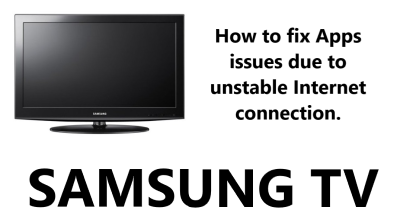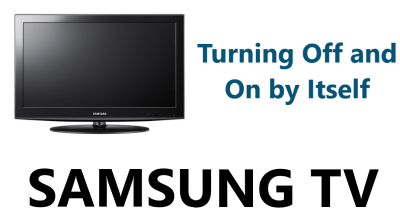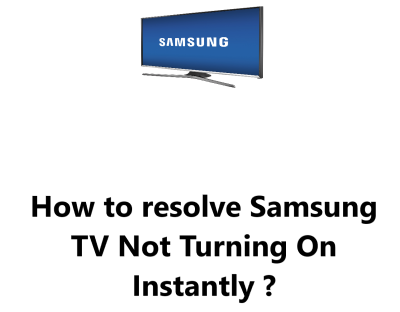Unable to Power Off your Samsung Smart TV - How to fix it ?
Samsung TVTrying to turn off your Samsung Smart TV and not being able to can be incredibly annoying.
There are a few main reasons why your Samsung Smart TV might not be turning off. These include:
- A faulty power button or remote control.
- A software glitch or bug.
- A hardware problem with the TV itself.
In this guide by Fixwebnode , we will discuss some troubleshooting steps you can take to fix your Samsung Smart TV that won't turn off.
Table of contents [Show]
-
1
What to do when you are Unable to Power Off a Samsung Smart TV
- 1. 1 1. Check the TV power button
- 1. 2 2. Inspect the Power Cabling
- 1. 3 3. Inspect TV Remote Batteries
- 1. 4 4. Check if IR Port is Blocked
- 1. 5 5. Perform HDMI CEC Check
- 1. 6 6. Check if Fluorescent Lights affects your TV Remote (If applicable)
- 1. 7 7. Perform Hard Power Reset
- 1. 8 8. Perform a factory reset
What to do when you are Unable to Power Off a Samsung Smart TV
Here are a few things you can do to fix the problem:
If the TV was powered on by using the power button located on the TV rather than the remote, it may not answer commands through the remote.
So Make sure that the power button on your TV is not stuck.
You can try pressing and holding the power button on the TV itself for a few seconds to see if it will turn off.
2. Inspect the Power Cabling
- To make sure your cables and sockets are functioning correctly, let's ascertain the cabling is firmly plugged in.
- If that does not do the trick, try a new outlet.
- In the event that your television will not switch on and you can unplug the power cord, then try using a different one.
3. Inspect TV Remote Batteries
- Take the back cover off, and remove the 2 batteries.
- Re-insert the 2 batteries and return the back cover back onto the remote, sliding it down until it is securely in place.
- If the remote still fails to respond, replace the existing set of batteries with fresh ones.
4. Check if IR Port is Blocked
If your TV is setup in a certain way, an obstacle or something may interfere with the infra-red signals your remote control transmits, making it harder for the television to detect them.
Make sure that your TV's IR sensor is in view and that nothing can prevent your remote control from connecting to it.
Low-profile televisions often have their IR sensor hidden, but it can be easily found by shining a flashlight around the outer bezel of the TV.
When it comes to IR sensor location, some televisions are more easy to identify.
5. Perform HDMI CEC Check
HDMI CEC (Consumer Electronics Control), also known as "Control over HDMI" is a feature built into many Smart TVs. Through this feature, when a cable, satellite, or Blu-Ray player device is powered on, it sends a signal along the HDMI cable, prompting the TV to turn on.
Disconnect any connected devices, such as a cable box, streaming media player, or Blu-Ray player. This will invoke the HDMI CEC feature built into some Smart TVs, which will turn it off automatically. Just note that this action may disable the power button on your remote.
6. Check if Fluorescent Lights affects your TV Remote (If applicable)
As a fluorescent light fades away, it starts emitting not only visible light but also infra-red and radio waves.
Your Smart TV depends on infra-red signals from your remote to function. When there is too much activity in the infra-red spectrum, for example from a flickering fluorescent light, the TV may have trouble sensing the infra-red signal from the remote control.
Now try to switch off any lights near you, and then give the remote another try. If the remote works correctly afterwards, the lamp you had turned off is the source of the interference and needs to be replaced.
7. Perform Hard Power Reset
If the issue persists then It appears that your Smart TV's basic control system has crashed.
So it will need to be power cycled in order to resolve the issue that has not been fixed by the previous troubleshooting steps.
To do this:
- Unplug the TV from the wall socket.
- Leave it for 10 seconds.
- Plug it back in.
- Test it to ensure it turns on and off correctly.
8. Perform a factory reset
If the above steps don't work, you can try performing a factory reset on your TV.
A factory reset is a process that restores a device to its original settings. This means that all of the data on the device, including saved settings, apps, and files, will be erased.
Performing a factory reset on a Samsung Smart TV can be a helpful troubleshooting step if the TV is experiencing problems, such as not turning off. It can also be used to erase all of your personal data from the TV if you are selling it or giving it away.
This will erase all of your settings and data, so make sure to back up anything important first.
To perform a factory reset, follow these steps:
- Press the Home button on your remote control.
- Select Settings.
- Select General.
- Select Reset.
- Select Reset to Factory Settings.
- Enter your PIN, if prompted.
- Select Yes.
The TV will then reset to its original settings. This process may take a few minutes to complete.
Once the factory reset is complete, you will need to set up the TV again. This includes connecting it to your network, signing in to your streaming services, and restoring any saved settings or files.
NOTE:
- Make sure to back up any important data or settings before you reset the TV.
- The factory reset will erase all of your personal data from the TV, including saved passwords, login information, and home screen settings.
- The factory reset process may take a few minutes to complete.
- After the factory reset, you will need to set up the TV again.
In this guide, we have discussed some troubleshooting steps you can take if your Samsung Smart TV won't turn off.
These steps include checking the power button, checking the remote control, resetting the TV, and performing a factory reset.
Here are some additional tips to help prevent your Samsung Smart TV from turning off:
- Make sure that the TV is not in standby mode. Standby mode will keep the TV powered on even when it is turned off, so make sure to turn it off completely.
- Avoid using too many apps at the same time. Using too many apps can overload the TV and cause it to freeze or crash.
- Keep the TV's software up to date. Samsung regularly releases software updates that can fix bugs and improve performance.
Note:
- Samsung offers a one-year warranty on its Smart TVs, so you may be able to get your TV repaired or replaced for free under warranty via https://www.samsung.com/us/support/warranty/.
- You can also find additional troubleshooting tips and support information on Samsung's website via https://www.samsung.com/us/support/televisions-home-theater/televisions/.








